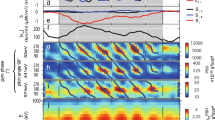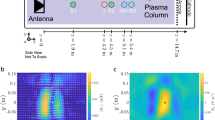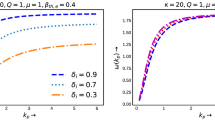Abstract
THE theory of electrostatic waves is highly developed1–3. The propagation of electrostatic waves has been observed in laboratory plasmas by measuring the time required for a pulse of these waves to travel between antennae imbedded in the plasma4. Resonance phenomena have been expected to appear in a plasma irradiated with radio waves at frequencies for which the group velocity of the electrostatic waves is zero or small. This concept has been used5 to explain certain previously observed resonances. Bernstein's theory, however, also predicts zero group velocity at frequencies for which resonances have not previously been observed. A simplified approximate equation has been developed by Stix6 and improved by Dougherty and Monaghan7 to predict the frequencies at which these electrostatic resonances should appear. The resonances observed by instruments carried on satellites may correspond to a finite group velocity that matches the velocity of the satellites.
This is a preview of subscription content, access via your institution
Access options
Subscribe to this journal
Receive 51 print issues and online access
$199.00 per year
only $3.90 per issue
Buy this article
- Purchase on Springer Link
- Instant access to full article PDF
Prices may be subject to local taxes which are calculated during checkout
Similar content being viewed by others
References
Gross, E. P., Phys. Rev., 82, 232 (1951).
Bernstein, I. B., Phys. Rev., 109, 10 (1958).
Shkarofsky, I. P., Phys. of Fluids, 9, 570 (1966).
Crawford, F. W., Harp, R. S., and Mantei, T. D., J. Geophys. Res., 72, 57 (1967).
Fejer, J. A., and Calvert, W., J. Geophys. Res., 69, 5049 (1964).
Stix, T. H., The Theory of Plasma Waves (McGraw-Hill, New York, 1962).
Dougherty, J. P., and Monaghan, J. J., Proc. Roy. Soc., A, 289, 214 (1965).
In Handbook of Mathematical Functions with Formulas, Graphs, and Mathematical Tables (edit, biy Abramowitz, M., and Stegun, I. A.) (available from Superintendent of Documents, US Government Printing Office, Washington).
Shkarofsky, I. P., Res. Rep. No. 7–801–63 (February 1968) (RCA Research Laboratories, Montreal, Canada), to be published in Proc. NATO Advanced Study Institute on Plasma Waves in Space and in the Laboratory, Røros, Norway, 1968.
Author information
Authors and Affiliations
Rights and permissions
About this article
Cite this article
WARREN, E., HAGG, E. Observation of Electrostatic Resonances of the Ionospheric Plasma. Nature 220, 466–468 (1968). https://doi.org/10.1038/220466a0
Received:
Revised:
Issue Date:
DOI: https://doi.org/10.1038/220466a0
This article is cited by
-
Effects of the Angle Between the Density Gradient and the External Magnetic Field on the Linear Mode Conversion and Resultant Beaming Angle of LO-Mode Radio Emissions
Earth, Moon, and Planets (2014)
-
Simulation of mode conversion from UHR-mode wave to LO-mode wave in an inhomogeneous plasma with different wave normal angles
Earth, Planets and Space (2009)
-
Electrostatic electron cyclotron harmonic waves observed by the Akebono satellite near the equatorial region of the plasmasphere
Earth, Planets and Space (2007)
Comments
By submitting a comment you agree to abide by our Terms and Community Guidelines. If you find something abusive or that does not comply with our terms or guidelines please flag it as inappropriate.



